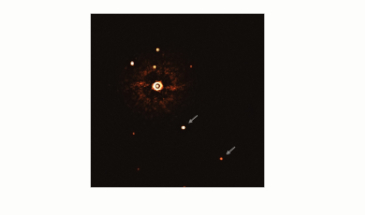- Series:Astronomy, Creation, Transcript English
Jude 1:13
“Raging waves of the sea, foaming out their own shame; wandering stars, to whom is reserved the blackness of darkness for ever.”
 The headline “Scientist Sees Planets with Very Large Telescope” might not excite the imagination until you realize that the Very Large Telescope, or VLT, is actually a thing! It is a huge reflecting telescope, built by the European Southern Observatory in the desert in Chile. It is actually comprised of four telescopes, each of which has a primary hyperbolic mirror about 27 feet across. The result is that the instrument can “see” objects millions of times fainter than those detected by the human eye.
The headline “Scientist Sees Planets with Very Large Telescope” might not excite the imagination until you realize that the Very Large Telescope, or VLT, is actually a thing! It is a huge reflecting telescope, built by the European Southern Observatory in the desert in Chile. It is actually comprised of four telescopes, each of which has a primary hyperbolic mirror about 27 feet across. The result is that the instrument can “see” objects millions of times fainter than those detected by the human eye.
Recently, the VLT was pointed at a star rejoicing in the name TYC 8998-760-1, about 300 light years away. It was already known, from calculations, that the star had two planets orbiting it. So the VLT was able to take a magnificent photograph of the stellar system, clearly showing these planets.
Both planets are gas giants. The one closer to the star is 14 times more massive than Jupiter, while the other is six times bigger. The planets are 160 and 320 times further from their star than the Earth is from the Sun, compared with just five and ten times the Earth-Sun distance for Jupiter and Saturn.
The article describing the photo inevitably speculates on the supposed “evolution” of these planets and whether or not there may be others with evolved life. Creationists will not waste time on such idle speculation but rejoice that even more of the heavens that declare God’s glory have now been revealed.
Prayer: When we look into Your heavens, Lord God, our Creator, we, like the psalmist before us, are struck with awe at the wonder of Your creation. Amen.
Author: Paul F. Taylor
Ref: ESO. “First ever image of a multi-planet system around a sun-like star captured by ESO telescope.” ScienceDaily, 22 July 2020. <www.sciencedaily.com/releases/2020/07/200722093501.htm>. Image: ESO image, from VLT; CC BY-SA 4.0 International.
© 2022 Creation Moments. All rights reserved.
